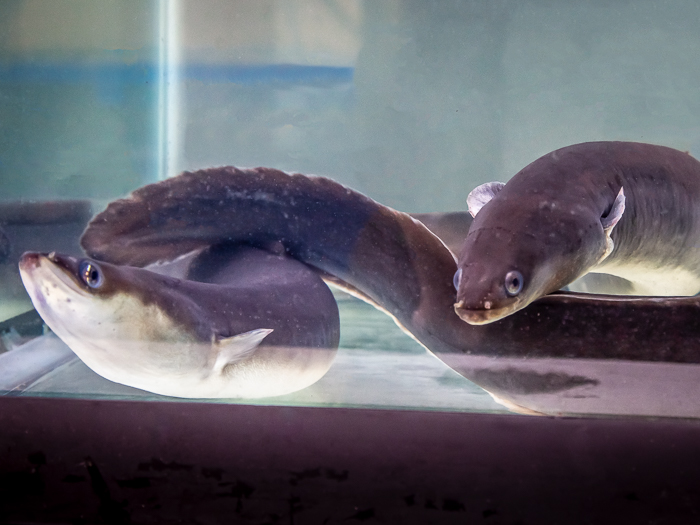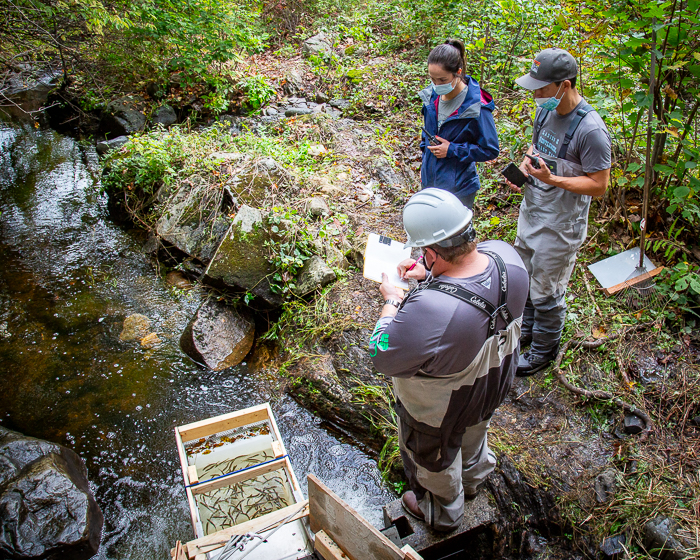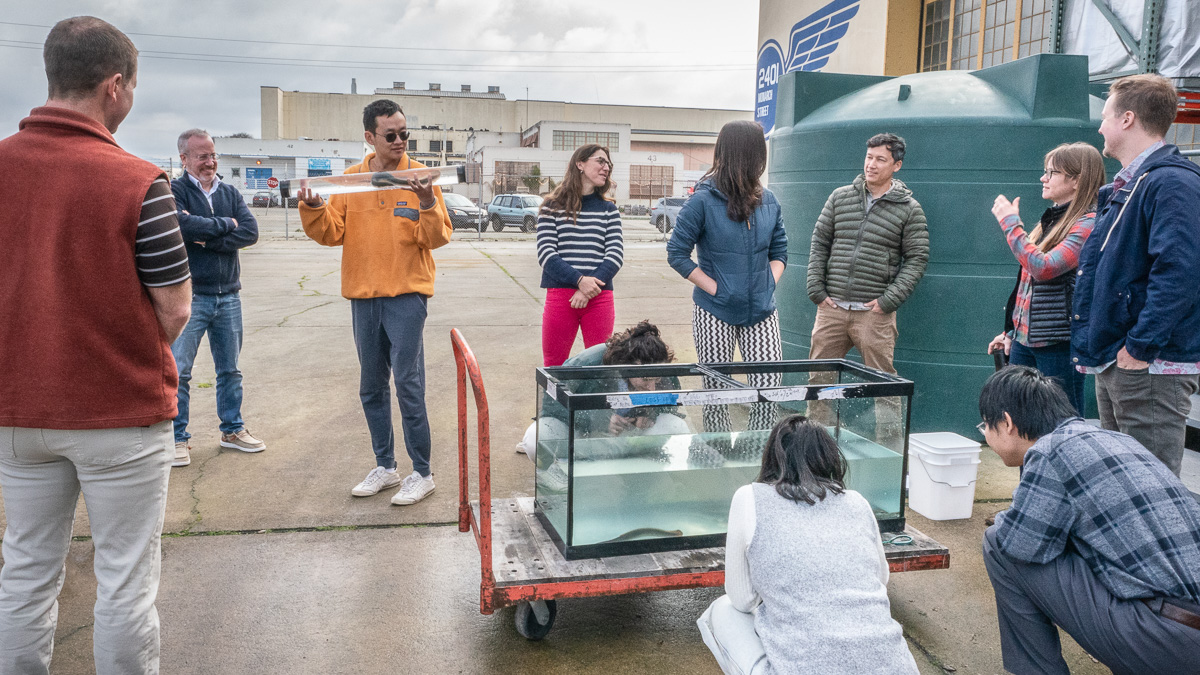By publishing data about how fish interact with our turbine designs we invite feedback from experts and advance scientific knowledge about through-turbine fish passage to improve fish survival at hydropower plants.
From the beginning, collecting information about how real fish interact with our Restoration Hydro Turbines (RHTs) has been an integral part of our design process. We’ve performed controlled laboratory and field studies with biologists and engineering partners from the Pacific Northwest National Laboratory; Kleinschmidt Associates; University of California, Davis; and the Alden Research Laboratory (now Verdantas) to understand the effects of the RHTs on migratory fish species across a range of operating conditions.

Environmental and sustainability indicators
Maximizing safe passage for large fish: Evaluating survival of rainbow trout through a novel hydropower turbine
As hydropower continues to play an important role in renewable energy production, there is a continuing need to mitigate or eliminate the negative effects of hydropower on fish populations. This study examined a novel hydropower turbine (Restoration Hydro Turbine) designed to maximize safe passage with survival rates exceeding 99 %. Tests using adult hatchery-reared rainbow trout (Oncorhynchus mykiss) were performed over two trial periods, one in 2020 and the other in 2022, at the Monroe Drop Facility in Jefferson County, Oregon. Of the 166 treatment and 141 control fish tested over the two years (fork length 200–530 mm, mass 305.0–1225.5 g), no immediate mortalities or major injuries were observed. The results of this study indicate a very high likelihood of immediate survival (100 % in 2020, 98.6 % in 2022) for rainbow trout in the size range examined when passing through the turbine. The absence of major injuries and mortalities attributable to turbine passage demonstrates the potential of novel turbine designs to minimize fish injury during hydropower generation.
Brett D. Pflugrath, Robert P. Mueller, Katherine A. Deters, Sterling M. Watson, Abraham D. Schneider, Zhiqun Daniel Deng. (2025). Maximizing safe passage for large fish: Evaluating survival of rainbow trout through a novel hydropower turbine. Environmental and Sustainability Indicators, Volume 27. https://doi.org/10.1016/j.indic.2025.100801
Read the Full Article
Transactions of the American Fisheries Society
Safe passage of American eels through a novel hydropower turbine
The objective of this study was to observe the effects of downstream passage through a novel turbine designed for fish safety, the Restoration Hydro Turbine (RHT), on American Eels (Anguilla rostrata) in a recirculating turbine test facility. A 55-cm-diameter RHT was operated under 10 m of hydraulic head and 667 revolutions/min. In total, 131 eels were passed through the turbine and 43 eels were used as experimental controls (length = 33.9–65.5 cm). High-speed video of passage through the runner region was captured for 89% of turbine-passed eels, and injury and behavioral effects were recorded immediately before and after passage, as well as after a 48-h holding period. A subset of 37 eels was additionally examined with X-ray imaging for internal injuries. The 48-h survival rate for both treatment and control groups was 100%, with no major internal or external injuries present after the holding period. This is a substantial improvement over eel survival rates through conventional Kaplan and Francis turbines, which may range from 40% to 95%, and suggests that hydropower turbines designed for safe downstream fish passage could be implemented without major impacts to eels. Mature American Eels migrate down rivers to spawn in the ocean, and may pass hydropower dams where the risk of entrainment in turbine intakes is high. In this study, eels were passed through a novel propeller-style turbine with a survival rate of 100%, a substantial improvement over conventional turbines.
Watson, S., Schneider, A., Santen, L., Deters, K. A., Mueller, R., Pflugrath, B., Stephenson, J., & Deng, Z. D. (2022). Safe passage of American eels through a novel hydropower turbine. Transactions of the American Fisheries Society, 151, 711–1. https://doi.org/10.1002/tafs.10385

Journal of Environmental management
Estimated capital costs of fish exclusion technologies for hydropower facilities
Hydropower is a reliable source of renewable energy, and its future expansion is likely to be in the form of either smaller new stream development (NSD) projects or powering existing non-powered dams. Thresholds for entrainment risk to fish and the requirements for fish exclusion at hydropower facilities often differ depending on the species involved, the characteristics of the facility, and the goals of stakeholders, but little quantitative information is present within the literature regarding the specific costs of fish exclusion measures. Cost data associated with protection, mitigation, and enhancement (PM&E) measures related to positive barrier screening were identified using keyword searches of an existing environmental mitigation cost data set and manual extraction from regulatory licensing documents available in the Federal Energy Regulatory Commission (FERC) eLibrary. This approach yielded a total of 50 p.m.&E mitigation measures with estimated capital construction costs pertaining to positive barrier screens and represented
Paul G. Matson, Kevin M. Stewart, Gbadebo A. Oladosu, Emrat Nur Marzan, Scott T. DeNeale (2024). Estimated capital costs of fish exclusion technologies for hydropower facilities, Journal of Environmental Management, Vol. 351, 2024. https://doi.org/10.1016/j.jenvman.2023.119800
Read the Full Article
North American Journal of Fisheries Management
Juvenile alewife passage through a compact hydropower turbine designed for fish passage
Hydropower is a valuable renewable energy source, but its effects on the downstream passage of many riverine fish species are not well understood. Turbines that are designed to function as safe downstream passage routes for fish are being developed with the goal of mitigating the effects of hydropower operations on the environment. In this paper, we present the results of a study conducted with the juvenile life stage of the alewife (Alosa pseudoharengus), a major migratory species on the Atlantic coast of North America. The test was conducted at a small hydropower plant located in Freedom, Maine, with a single Restoration Hydro Turbine (RHT) operating under 7.5 m of gross head. Groups of 140–170 fish were released into the intake of a 55-cm-diameter RHT and were recaptured with a specialized trap at the turbine discharge outlet. The combined immediate and 48-h survival rates (±95% CI) for all treatments, corrected for control mortality, were 98.2 ± 2.0% and 100.0 ± 6.6%, respectively. The passage of alewives through the runner region of the turbine was also captured with high-speed video. The results of the study demonstrate that the RHT, which is designed for fish safety, is an effective way to pass juvenile alosines downstream at hydropower facilities.
Watson, S.M., Schneider, A.D., Gardner, L.C., Apell, B.R., Thompson, P.C., Cadman, G.B., Gagnon, I.F., Frese, C.R. and Wechsler, J.F. (2023), Juvenile Alewife Passage through a Compact Hydropower Turbine Designed for Fish Safety. North Am J Fish Manage, 43: 465-475. https://doi.org/10.1002/nafm.10866

Natel Energy white paper
Effects of Runner Blade Shape on Hydro-Abrasive Erosion in Hydropower Turbines
This study examines the impact of blade shape on hydro-abrasive erosion performance in hydropower turbines, aiming to assess whether a Natel FishSafe™ Restoration Hydro Turbine (RHT) runner blade shows improved wear resistance in addition to providing downstream passage for fish. Hydro-abrasive erosion is a significant problem in hydropower schemes located in mountainous regions and can lead to reduced efficiency of the turbine and even structural failure of components such as the runner, guide vanes, stay vanes, etc. We tested a conventional Kaplan/propeller-style sample as well as an RHT-style sample in a representative quartzite slurry pot test. The leading edge profiles were extracted by 3D scanning and analyzed for wear depth. The analysis shows that the wear rate of the RHT sample is reduced by approximately 80% compared to the conventional sample. This finding suggests that an increase in wear life of up to five times is feasible with a FishSafe™ runner designed by Natel Energy.
Johannes Santen, Kelsey Seto (2024) "Effects of Runner Blade Shape on Hydro-Abrasive Erosion in Hydropower Turbines," Natel Energy. https://www.natelenergy.com/publications

The International Journal On HydroPower & Dams
Design and validation of FishSafe™ hydro turbines for retrofit and new-build applications
Hydropower operations have significantly and detrimentally affected fish populations, both migratory and resident. This article focuses primarily on the downstream passage of fish through turbines, although there are many other related issues concerning the safe, timely, and effective passage of fish through hydropower facilities, as well as habitat change and flow alterations associated with hydropower operations. The design of FishSafe™ turbines has significant value, as such machines could lock-in substantial environmental sustainability improvements at hydropower facilities while also allowing for simple and familiar hydropower plant design and operations.
Schneider, A., Watson, S. (2023). Design and validation of FishSafe hydro turbines for retrofit and new-build applications. This paper was published in The International Journal on Hydropower & Dams, Issue 5 and was presented at the HYDRO 2023 conference in Edinburgh (October 2023).

Journal of Ecohydraulics
Improving survival: injury and mortality of fish struck by blades with slanted, blunt leading edges
Compact turbines offer potential to reduce hydropower plant construction costs, but conventional turbine blade designs endanger entrained fish due to high blade strike speeds and thin leading edges. We evaluated the potential for combined blade leading edge slant and large leading edge thickness to increase strike survival. Rainbow trout (Oncorhynchus mykiss) were subjected to strikes with 100 mm thick blade analogues. At 10 m/s, strikes at fish length to blade leading edge thickness ratio (L/t) of 2 resulted in 98% survival at a location along the blade witha 30° slant relative to the tangential direction, compared to 26.8% survival at a location with 90°slant. For L/t 1.14-2, survival was found to be sensitive to location of strike within the mid-body region, determined from high-speed video. Strikes of 200 mm fish at 10 m/s resulted in 68% survival when body strike location was 0.58 (near caudal), and 7.9% when body strike location was 0.36 (near head). These results are consistent with previous trends and indicate opportunities to improve turbine blade design for greater entrained fish survival at higher turbine speeds, at both low head (<30 m) and high head projects.
Stephen V. Amaral, Sterling M. Watson, Abraham D. Schneider, Jenna Rackovan & Andrew Baumgartner (2020) Improving survival: injury and mortality of fish struck by blades with slanted, blunt leading edges, Journal of Ecohydraulics, 5:2, 175-183. 10.1080/24705357.2020.1768166

Water
Examination of an electrified bar rack fish guidance device for hydropower turbines
The potential of hydropower turbines to cause injury or mortality to fish is a concern. To reduce this risk, engineers have begun to develop a conically arranged, cantilevered electrified bar rack (Center Sender). This device is proposed to be mounted within the intake of a turbine, guiding downstream-passing fish towards the center of the turbine where blade velocities are lower and blades are thicker, likely reducing the potential for fish to be injured. A simplified version was installed in a flume for testing with Rainbow trout (Oncorhynchus mykiss) while examining several parameters such as electrification, bar spacing, bar angle, and water velocity. The most effective settings were observed to be a water velocity of 1.0 m s−1 with all bars installed at an angle of 40° with electrification on. Other combinations were still effective but had varying results. A minimal proportion (2.3%) of fish passed at lower velocities with bars electrified and mounted at 20°, suggesting that while it functions well as a guidance device in high-velocity conditions, it performs better as a barrier at lower velocities. The study suggests that the Center Sender has promising potential for reducing the harmful effects of hydropower turbines on fish populations by guiding them away from stressors. Further research is needed, but current results encourage its potential use in hydropower operations.
Pflugrath BD, Watson S, Haug J, Harnish R, Colotelo AHA, Schneider A. (2023). Examination of an Electrified Bar Rack Fish Guidance Device for Hydropower Turbines. Water, 15(15):2786. https://doi.org/10.3390/w15152786

.png)


